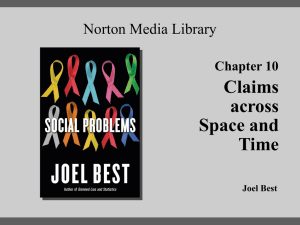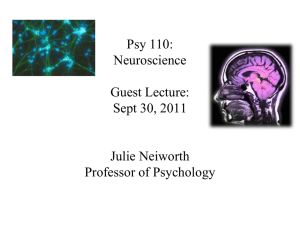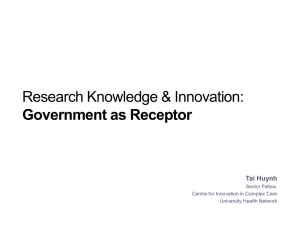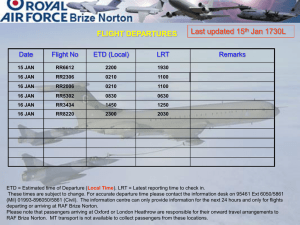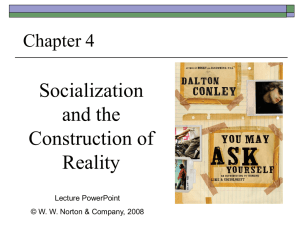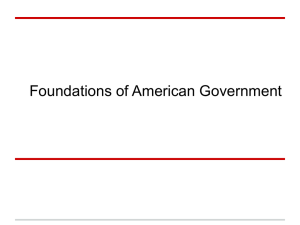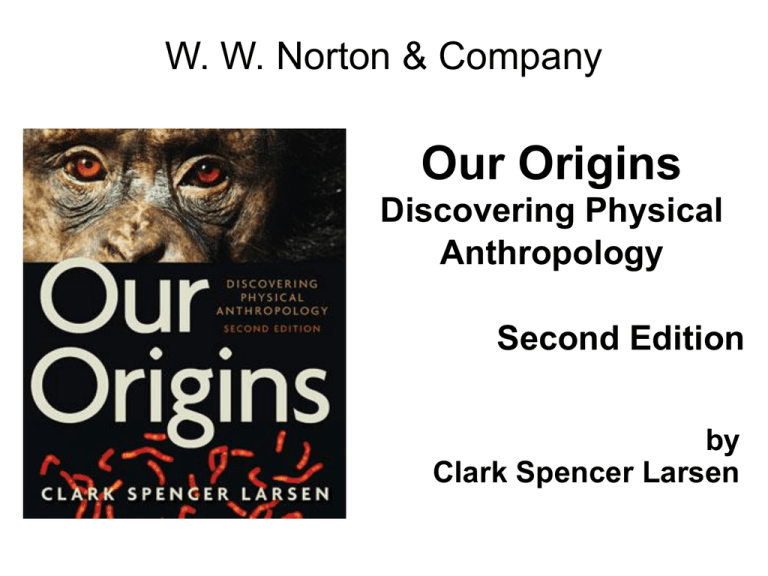
W. W. Norton & Company
Our Origins
Discovering Physical
Anthropology
Second Edition
by
Clark Spencer Larsen
Chapter 3
Clark Spencer Larsen
Our Origins
DISCOVERING PHYSICAL ANTHROPOLOGY
Chapter 3
Genetics: Reproducing Life and
Producing Variation
©2011 W. W. Norton & Company, Inc.
The Cell
Two types of organisms
–
–
Prokaryote (one cell)
Eukaryote (many cells)
The Cell
Two types of cells
–
–
Somatic (body) cells
Gamete (reproductive) cells
Figure 3.3f Somatic Cells—Skin Cells
Our Origins, 2nd Edition
Copyright © 2011 W.W. Norton & Company
Figure 3.4a Gametes—Human Male Sex Cells
Our Origins, 2nd Edition
Copyright © 2011 W.W. Norton & Company
The DNA Molecule
Nuclear DNA
–
–
–
Contained within the nucleus of a cell
Makes up chromosomes
Complete set called genome
Figure 3.5a Chromosomes
Our Origins, 2nd Edition
Copyright © 2011 W.W. Norton & Company
The DNA Molecule
Mitochondrial DNA
–
–
Contained in organelles in cell’s
cytoplasm
Inherited from the mother
The DNA Molecule
DNA: the blueprint of life
–
–
Chemical template for every aspect of
organisms
Double helix, ladderlike structure
•
•
Ladder forms nucleotide
Ladder base made up of four types
–
–
Adenine, thymine, guanine, cytosine
Complementary pairs (A&T, C&G)
Replicating the Code
One function of the DNA molecule is
replication
–
–
Part of cell division—meiosis or mitosis
DNA makes identical copies of itself
Chromosome Types
–
Occur in homologous (matching) pairs
•
One in each pair from each parent
Figure 3.12a The Human Karyotype Consists of 46
Chromosomes of Various Sizes in 23 Pairs
Our Origins, 2nd Edition
Copyright © 2011 W.W. Norton & Company
Replicating the Code
Autosomes (nonsex chromosomes)
Sex chromosomes
–
–
–
X, Y
Females carry only X chromosomes,
while males have one X and one Y
chromosome
The father determines the sex of the
offspring
Mitosis: Production of Identical
Somatic Cells
DNA replication followed by one cell
division
Diploid cell (contains full set of
chromosomes)
Figure 3.14a The Steps of Mitosis in Humans
Our Origins, 2nd Edition
Copyright © 2011 W.W. Norton & Company
Meiosis: Production of Gametes
One DNA replication followed by two
cell divisions
Gametes are haploid (half the number
of chromosomes)
Does not result in identical cell copies
Errors can occur during meiosis
–
Nondisjunction, translocation
Figure 3.15 Meiosis
Our Origins, 2nd Edition
Copyright © 2011 W.W. Norton & Company
Producing Proteins
Proteins are chemicals that make up
tissues
Also regulate functions, repair, and
growth of tissues
Proteins are made up of amino acids
–
Twenty different types
Producing Proteins
Structural proteins responsible for
physical characteristics
Regulatory proteins responsible for
functions: enzymes, hormones,
antibodies
Protein synthesis involves two steps.
–
–
Transcription (unzipping, template for
RNA)
Translation (template attaches to
ribosomes)
Producing Proteins
DNA in protein synthesis is coding DNA.
Most of human DNA is noncoding.
Genes: Structural and Regulatory
Structural genes are responsible for
body structures.
Regulatory genes turn other genes on
and off.
–
–
Homeotic (Hox) genes
Master genes
Figure 3.21 Homeotic (Hox) Genes
Our Origins, 2nd Edition
Copyright © 2011 W.W. Norton & Company
Polymorphisms
Each gene has a specific physical
location (locus).
Loci are valuable to understanding
genetic variation.
Alleles on different loci are chemically
alternative versions of the same gene.
Polymorphisms
Some genes have one allele, while
others have more
–
Mendel’s Law of Segregation: a parent
passes one allele to offspring
Single Nucleotide Polymorphisms (SNPs)
–
Make up variation between and within
human populations
Figure 3.23 Law of Segregation
Our Origins, 2nd Edition
Copyright © 2011 W.W. Norton & Company
Polymorphisms
Genotypes and phenotypes: genes and
their physical expression
–
–
Chemically identical alleles are termed
homozygous.
Chemically different alleles are
heterozygous.
•
•
Dominant allele is expressed in the
pair.
For a recessive allele to be expressed,
there must be two copies.
Polygenic Variation and
Pleiotropy
Much of genetics is based on the “one
gene, one protein” model.
However, many traits are polygenic and
are determined by genes at more than
one locus.
Polygenic Variation and
Pleiotropy
For some traits, only some of the
genetic variation can be calculated
(heritability).
–
–
Heritability ranges from 0 (none of the
variation is genetic) to 1 (all of the
variation is genetic).
Only heritable traits respond to natural
selection.
Polygenic Variation and
Pleiotropy
Measurement of heritability is
complicated by pleiotropy, or a single
allele having multiple effects.
–
Most complex traits are both
pleiotropic and polygenic.
Chapter 3: Clicker Questions
Human and chimpanzee DNA is about _____
similar.
a) 100%
b) 98%
c) 90%
d) 75%
Chapter 3: Clicker Questions
If one side of the DNA ladder includes the
sequence CTAATGT, the complementary base
configuration for this sequence will be:
a) GCAACGC.
b) AGCCGTG.
c) TAATGTC.
d) GATTACA.
Chapter 3: Clicker Questions
The human karyotype consists of ______ pairs of
chromosomes.
a) 23
b) 46
c) 48
d) 24
Chapter 3: Clicker Questions
Blocks of genetic material that do not recombine
and are passed on for generations are called:
a) phenotypes.
b) genotypes.
c) karyotypes.
d) haplotypes.
Chapter 3: Clicker Questions
Regulatory or functional proteins include:
a) lactase.
b) testosterone.
c) antibodies.
d) All of the above
Chapter 3: Clicker Questions
In protein synthesis, ___________ refers to
“unzipping” the DNA and ____________ refers
to the formation of polypeptide chains.
a) division; replication
b) transcription; translation
c) meiosis; mitosis
d) translocation; nondisjunction
Chapter 3: Clicker Questions
Prokaryotes have multiple cells while eukaryotes
have one.
a) True
b) False
Art Presentation Slides
Chapter 3
Chapter Opener
Our Origins, 2nd Edition
Copyright © 2011 W.W. Norton & Company
Figure 3.1 Cells and Their Organelles
Our Origins, 2nd Edition
Copyright © 2011 W.W. Norton & Company
Figure 3.2a Prokaryotes and Eukaryotes
Our Origins, 2nd Edition
Copyright © 2011 W.W. Norton & Company
Figure 3.2b A Bacteria that Aids Digestion in the Intestines
of Mammals, Including Humans
Our Origins, 2nd Edition
Copyright © 2011 W.W. Norton & Company
Figure 3.2c The Eukaryotic Cells of a Primate’s Kidney
Our Origins, 2nd Edition
Copyright © 2011 W.W. Norton & Company
Figure 3.3a Somatic Cells—A Heart Muscle
Our Origins, 2nd Edition
Copyright © 2011 W.W. Norton & Company
Figure 3.3b Somatic Cells—Brain Tissue
Our Origins, 2nd Edition
Copyright © 2011 W.W. Norton & Company
Figure 3.3c Somatic Cells—Motor Neurons (Nerve Cells)
Our Origins, 2nd Edition
Copyright © 2011 W.W. Norton & Company
Figure 3.3d Somatic Cells—Red Blood Cells (the Larger Cells Are
White Blood Cells, and the Small Dots Are Platelets)
Our Origins, 2nd Edition
Copyright © 2011 W.W. Norton & Company
Figure 3.3e Somatic Cells—Osteocyte (Bone Cell)
Our Origins, 2nd Edition
Copyright © 2011 W.W. Norton & Company
Figure 3.3f Somatic Cells—Skin Cells
Our Origins, 2nd Edition
Copyright © 2011 W.W. Norton & Company
Figure 3.4a Gametes—Human Male Sex Cells
Our Origins, 2nd Edition
Copyright © 2011 W.W. Norton & Company
Figure 3.4b Gametes—A Human Female Sex Cell
Our Origins, 2nd Edition
Copyright © 2011 W.W. Norton & Company
Figure 3.4c Gametes—Ovum
Our Origins, 2nd Edition
Copyright © 2011 W.W. Norton & Company
Figure 3.5a Chromosomes
Our Origins, 2nd Edition
Copyright © 2011 W.W. Norton & Company
Figure 3.5b Number of Chromosomes
Our Origins, 2nd Edition
Copyright © 2011 W.W. Norton & Company
Figure 3.6 Nuclear DNA
Our Origins, 2nd Edition
Copyright © 2011 W.W. Norton & Company
Figure 3.7 Mitochondrion
Our Origins, 2nd Edition
Copyright © 2011 W.W. Norton & Company
Figure 3.8 The Structure of DNA
Our Origins, 2nd Edition
Copyright © 2011 W.W. Norton & Company
Figure 3.9 Nucleotide
Our Origins, 2nd Edition
Copyright © 2011 W.W. Norton & Company
Figure 3.10 The Steps of DNA Replication
Our Origins, 2nd Edition
Copyright © 2011 W.W. Norton & Company
Human Chromosome 3
Our Origins, 2nd Edition
Copyright © 2011 W.W. Norton & Company
Normal Bone, on the Left, and Osteoporotic Bone, on the Right
Our Origins, 2nd Edition
Copyright © 2011 W.W. Norton & Company
DNA from 4,000-Year-Old Human Hair
Our Origins, 2nd Edition
Copyright © 2011 W.W. Norton & Company
Figure 3.11 Chromosome Pairs
Our Origins, 2nd Edition
Copyright © 2011 W.W. Norton & Company
Figure 3.12a The Human Karyotype Consists of 46
Chromosomes of Various Sizes in 23 Pairs
Our Origins, 2nd Edition
Copyright © 2011 W.W. Norton & Company
Figure 3.12b In this Karyotype, the Pair Labeled “XY”
Belong to a Human Male
Our Origins, 2nd Edition
Copyright © 2011 W.W. Norton & Company
Figure 3.13 Embryonic Development
Our Origins, 2nd Edition
Copyright © 2011 W.W. Norton & Company
Figure 3.14a The Steps of Mitosis in Humans
Our Origins, 2nd Edition
Copyright © 2011 W.W. Norton & Company
Figure 3.14b A Human Skin Cell Undergoing Mitosis, Dividing
into Two New Daughter Cells
Our Origins, 2nd Edition
Copyright © 2011 W.W. Norton & Company
The Skeletons of Native Americans
Our Origins, 2nd Edition
Copyright © 2011 W.W. Norton & Company
Figure 3.15 Meiosis
Our Origins, 2nd Edition
Copyright © 2011 W.W. Norton & Company
Figure 3.16a The Law of Independent Assortment, Asserts
Our Origins, 2nd Edition
Copyright © 2011 W.W. Norton & Company
Figure 3.16b Hair Color, for Example, Is Inherited
Independently from Eye Color
Our Origins, 2nd Edition
Copyright © 2011 W.W. Norton & Company
Figure 3.17 Linkage
Our Origins, 2nd Edition
Copyright © 2011 W.W. Norton & Company
Figure 3.18a Structural Proteins—Keratin
Our Origins, 2nd Edition
Copyright © 2011 W.W. Norton & Company
Figure 3.18b Structural Proteins-Collagen
Our Origins, 2nd Edition
Copyright © 2011 W.W. Norton & Company
Figure 3.19a Protein Synthesis
Our Origins, 2nd Edition
Copyright © 2011 W.W. Norton & Company
Figure 3.19b Protein Synthesis
Our Origins, 2nd Edition
Copyright © 2011 W.W. Norton & Company
Figure 3.20a The Hand on the Right Shows Normal Finger Growth.
The Hand on the Left Has Much Longer and Thinner Fingers.
Our Origins, 2nd Edition
Copyright © 2011 W.W. Norton & Company
Figure 3.20b Marfan Syndrome
Our Origins, 2nd Edition
Copyright © 2011 W.W. Norton & Company
Figure 3.21 Homeotic (Hox) Genes
Our Origins, 2nd Edition
Copyright © 2011 W.W. Norton & Company
Figure 3.22a Antibody–Antigen System
Our Origins, 2nd Edition
Copyright © 2011 W.W. Norton & Company
Figure 3.22b Antibody–Antigen System
Our Origins, 2nd Edition
Copyright © 2011 W.W. Norton & Company
Figure 3.23 Law of Segregation
Our Origins, 2nd Edition
Copyright © 2011 W.W. Norton & Company
Figure 3.24 Polygenic Traits and Pleiotropic Genes
Our Origins, 2nd Edition
Copyright © 2011 W.W. Norton & Company
Our Origins
StudySpace
Quizzes
Ebook Links
Outlines
FlashCards
Google Earth
AnthroTours
http://www.wwnorton.com/college/anthro/our-origins2
W. W. Norton & Company
Independent and Employee Owned
This concludes the slide set for Chapter 3
Our Origins
Discovering Physical Anthropology
Second Edition
by
Clark Spencer Larsen


